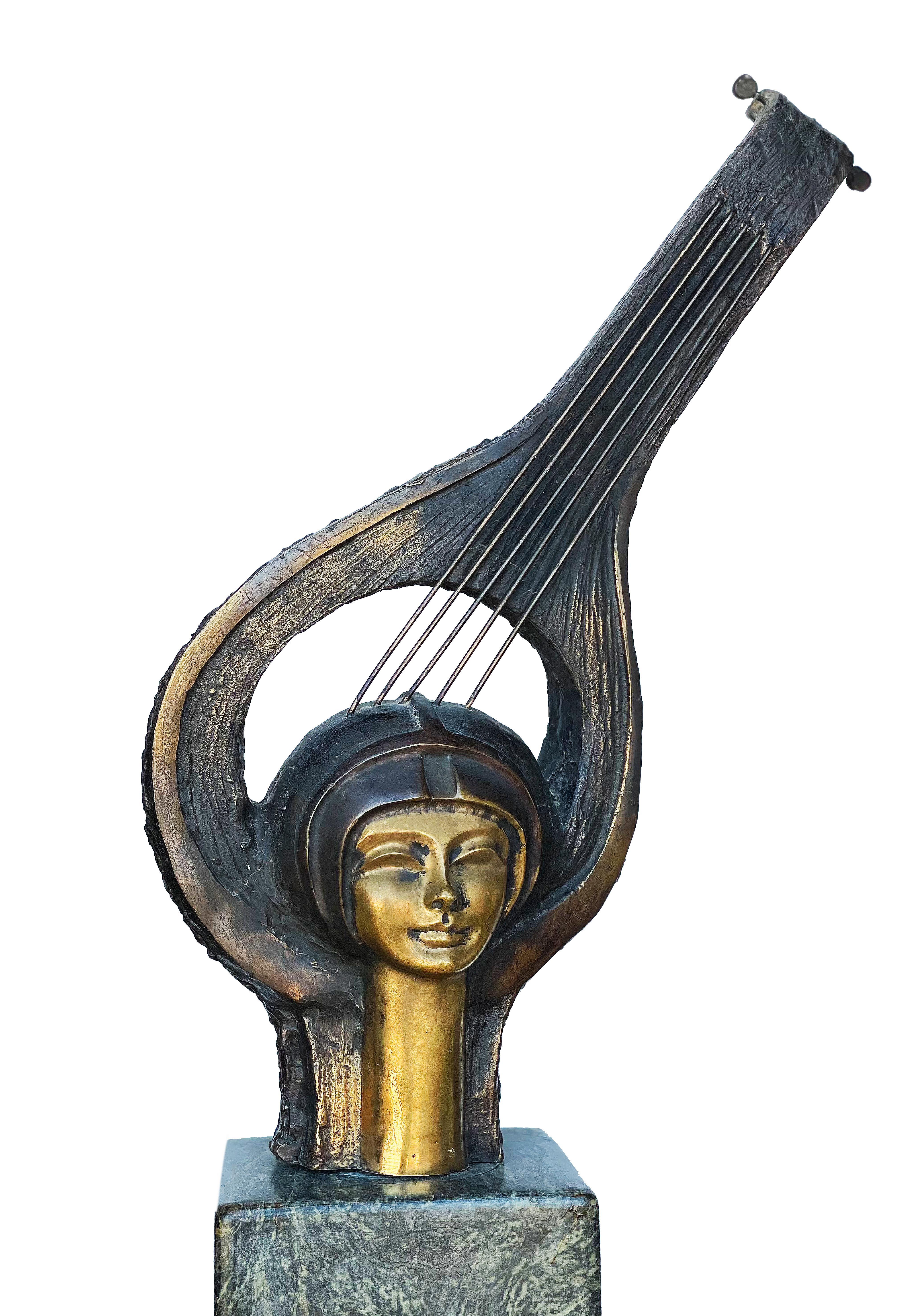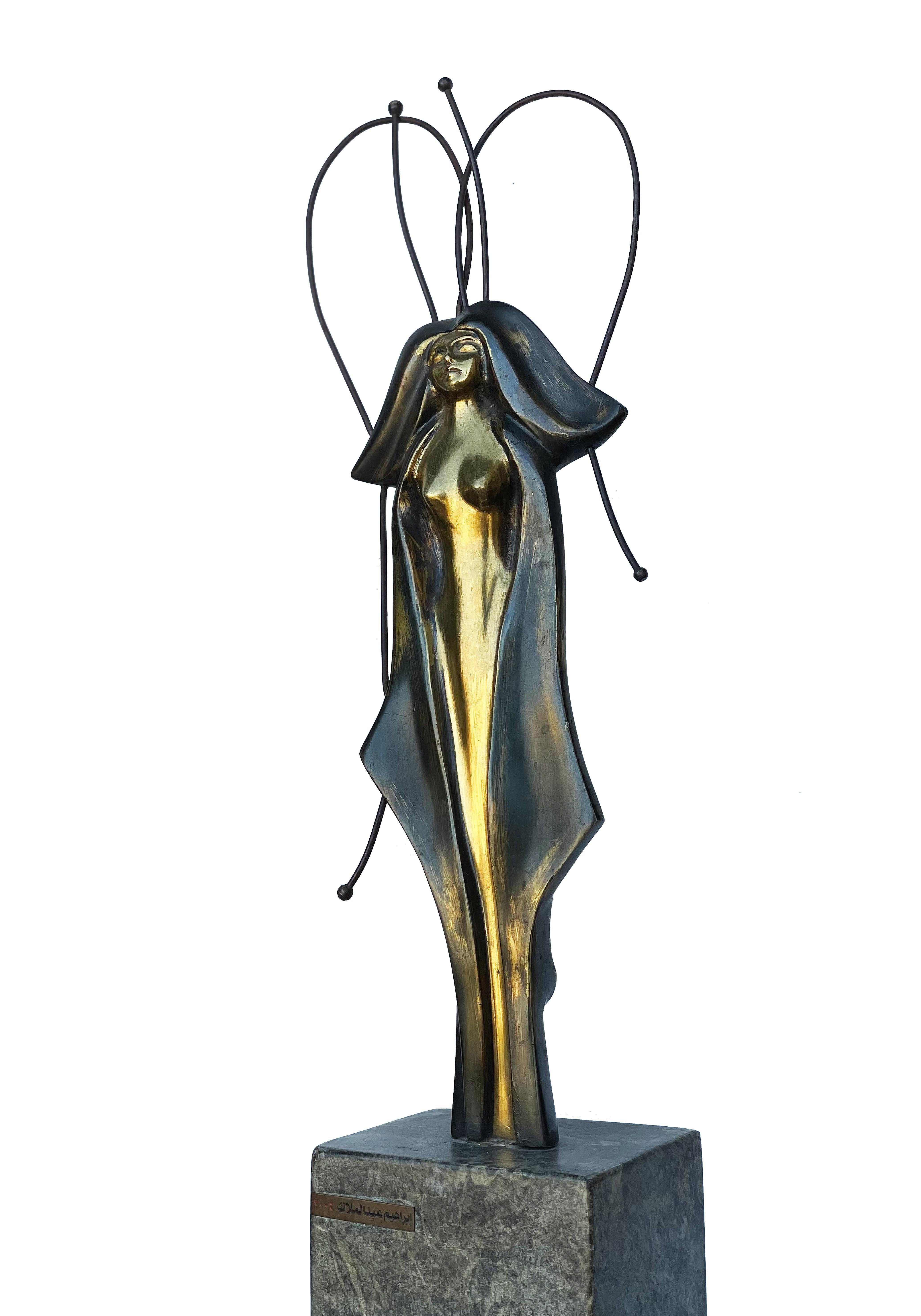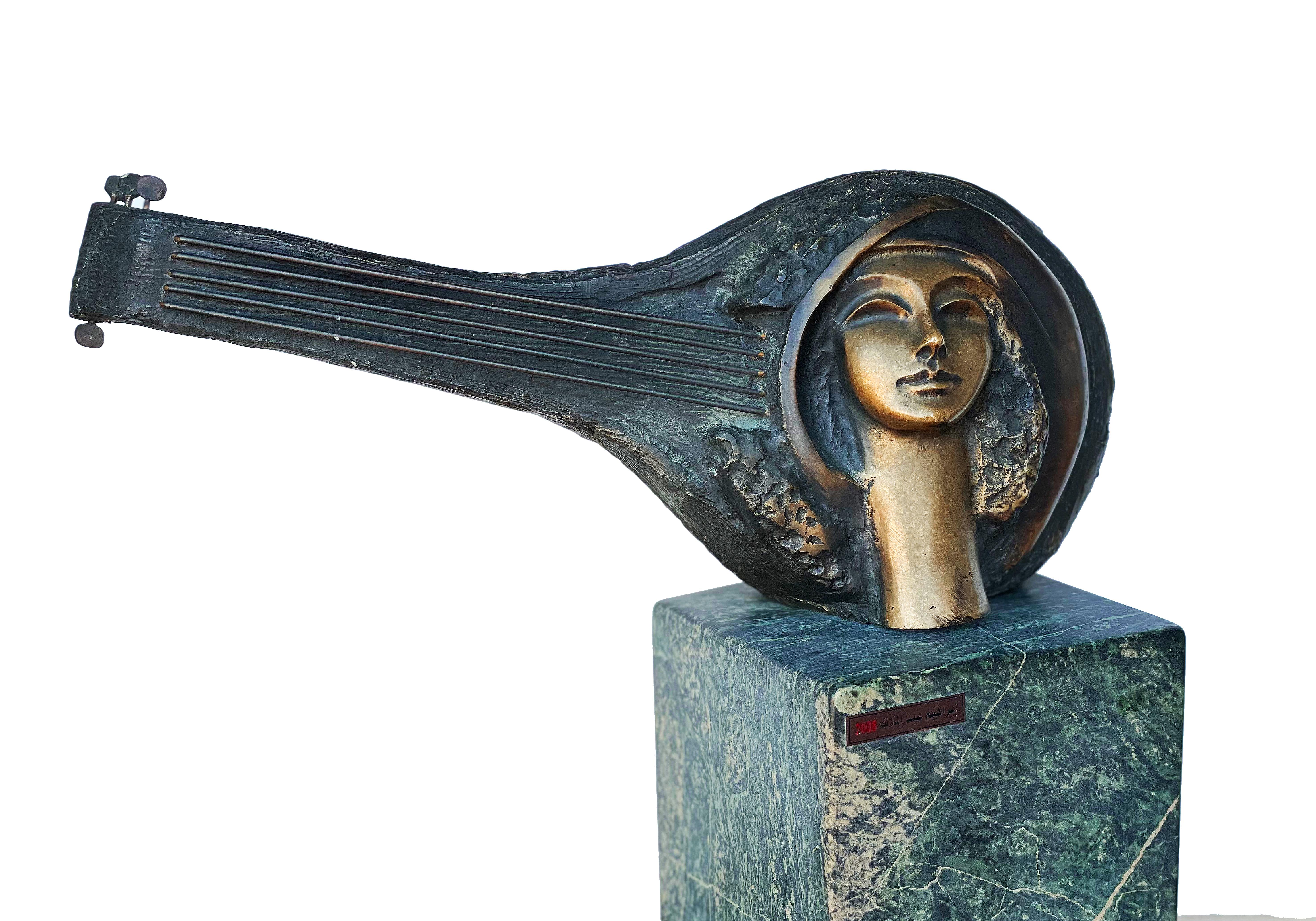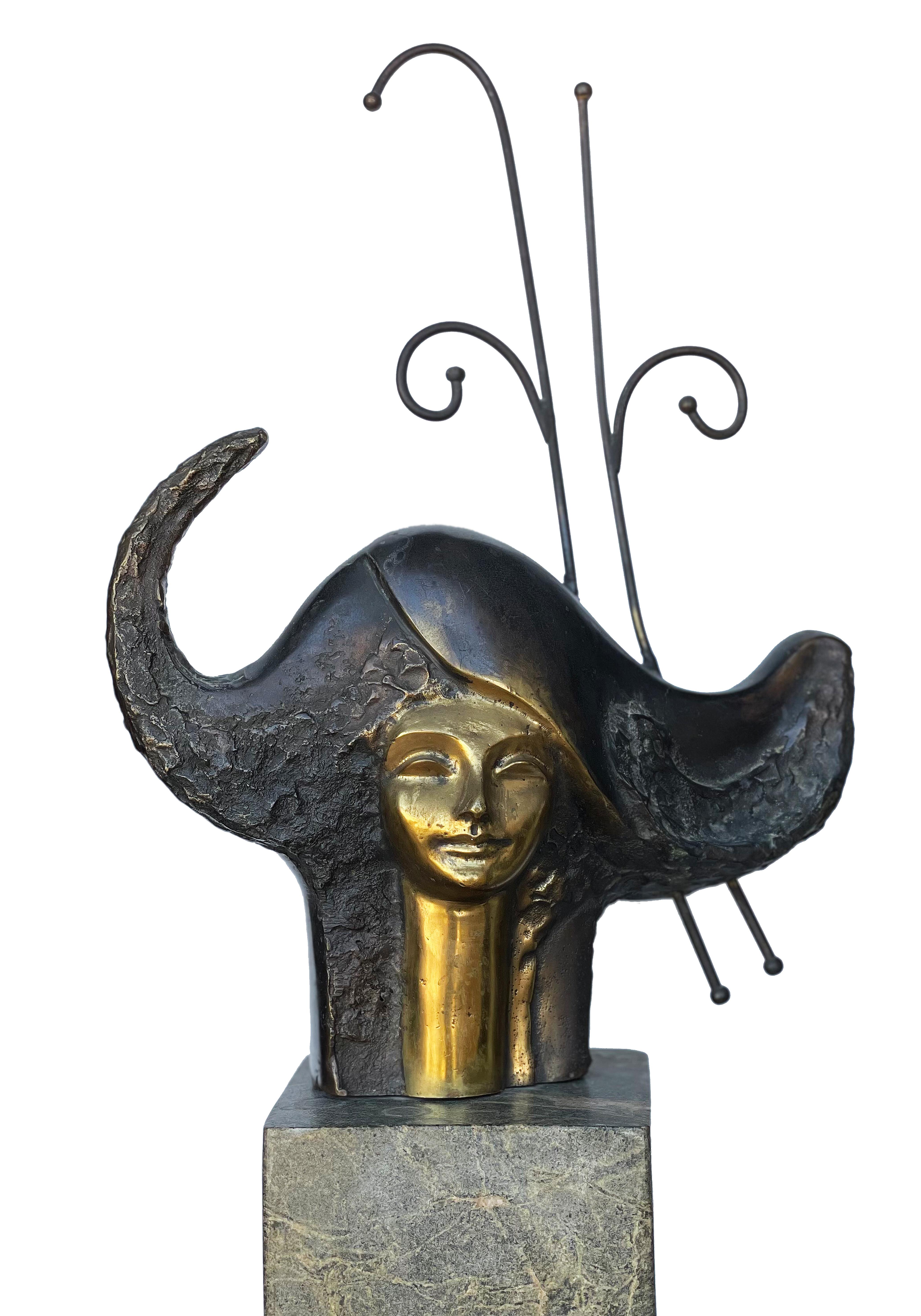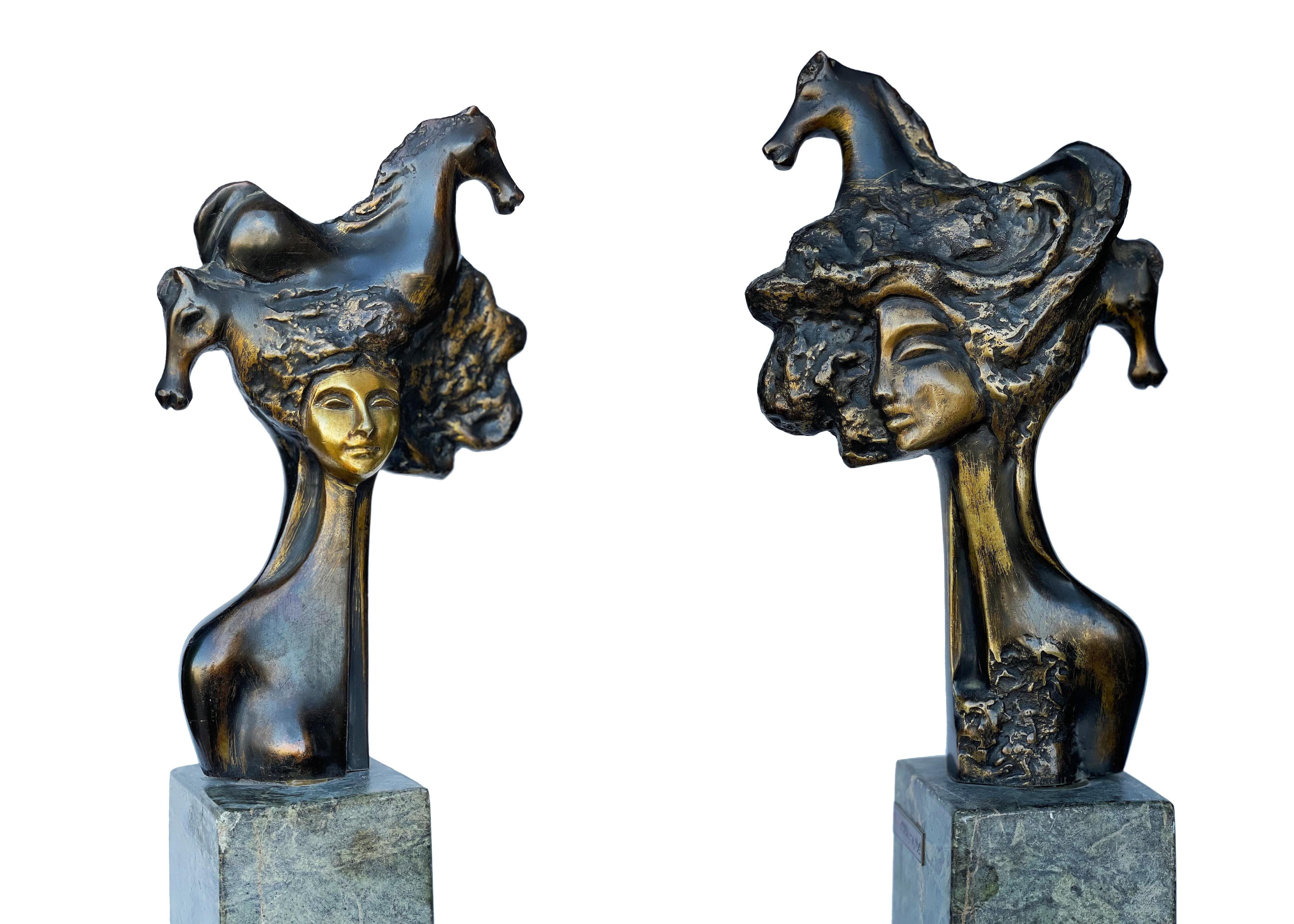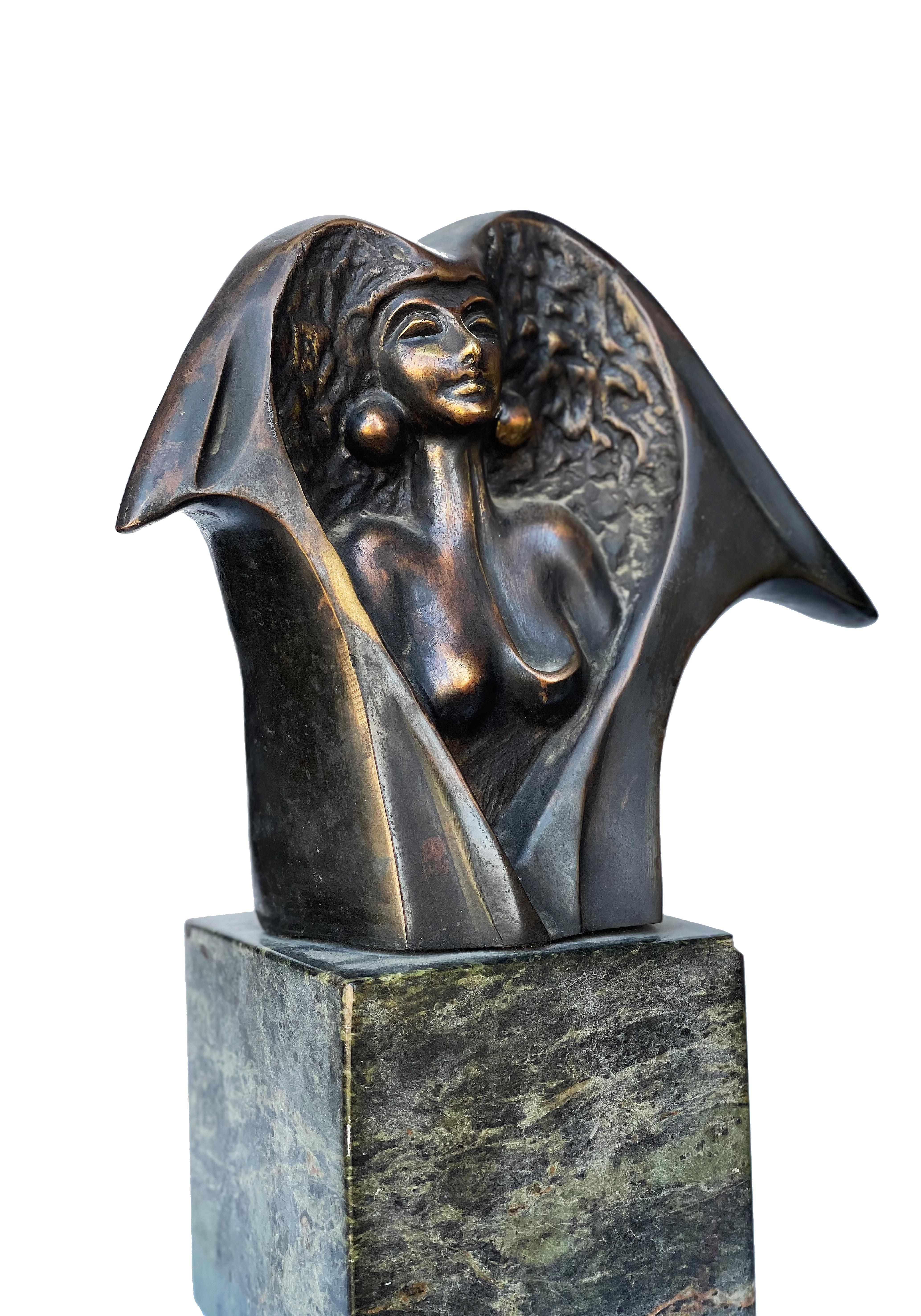Items Similar to Bronze Sculpture Abstract Brutalist Goat or Ram WPA Artist Mounted on Base
Want more images or videos?
Request additional images or videos from the seller
1 of 8
Benedict Michael TattiBronze Sculpture Abstract Brutalist Goat or Ram WPA Artist Mounted on Basec.1950's
c.1950's
About the Item
Benedict Tatti (1917-1993) worked in New York city as a sculptor, painter, educator, and video artist. He studied stone and wood carving under Louis Slobodkin at the Roerich Museum. He later attended the Leonardo da Vinci School of Art studying under Attilio Piccirelli. In l939 he taught adult classes with the Teachers Project of the WPA and attended the Art Students League for three and a half years on full scholarship. He studied under William Zorach and Ossip Zadkine and later became Zorach’s assistant. Later in his career, he attended the Hans Hofmann School of Fine Arts. During World War II, Tatti served in the United States Army Air Force, where he spent three years assigned to variety of projects. In 1948, Benedict Tatti married Adele Rosenberg in New York City.
Throughout his career, Tatti continuously experimented with various media. From 1952-1963, Tatti executed sculptural models of architectural and consumer products for the industrial designers, Raymond Loewy Associates; later he became a color consultant for the firm. In the 1960s, influenced by the Abstract Expressionists, Tatti turned from carving directly in wood and stone to creating assemblage architecture sculptures, using bronze metal and other industrial materials.
He was included in the important show "Aspects de la Sculpture Americaine", at Galerie Claude Bernard Paris, France, in October 1960 along with Ibram Lassaw, Theodore Roszak, David Smith, Louise Bourgeois, Danese Corey, Dorothy Dehner, Lin Emery, Lily Ente, David Hayes, Louise Nevelson, Tony Rosenthal, Richard Stankiewicz, Sam Szafran and Benedict Tatti. During this period, Tatti spent summers on Monhegan Island in Maine, where he developed his watercolor techniques. In the 1970s, Tatti, with no previous background in video work developed technology for video imaging. He became an associate member of the Kitchen at the Mercer Arts Center exhibiting his video sculptures along with other early innovators of this new art form. He assisted his brother, Alexander Tatti and his nephew, Steven Tatti on the restoration of the Statue of Liberty on Ellis Island. Benedict Tatti received solo and group exhibitions at museums and galleries in the United States and abroad, including the Burr Gallery, Claude Bernard Galleries, ACA Gallery, Puma Gallery, Weyhe Gallery and Metropolitan Museum of Art, under the Artists for Victory Program, Museum of Modern Art, National Gallery of Art, Northeast Gallery, Pennsylvania Academy of the Fine Arts, and the Roko Gallery. Also, Tatti's work was regularly featured in annual exhibitions of several arts organizations: American Society of Contemporary Artists, Annual Avant Garde Festival, Audubon Artists, Brooklyn Society of Artists, and Painters and Sculptors Society of New Jersey. His awards included the National Soldier Art Competition at the National Gallery of Art (1945); Artist-in-Residence, National Center of Experiments TV, San Francisco, California, (1969); and the Creative Artists Public Service (CAPS), (1972). Tatti's artwork is in the permanent collections of the American Numismatic Society, Art Students League, Dumbarton Oaks, Monhegan Museum, Smithsonian Institution, and the Usdan Center for the Creative and Performing Arts.
He won first prize for his sculpture, “Soldier”, in the National Soldier Art Competition, which was exhibited at the National Gallery of Art, Washington, D. C. and the Chicago Art Institute. He continued to direct carve both wood and stone into the decade of the fifties. He also developed his watercolor techniques during summer visits to Monhegan Island, Maine, where many of his friends summered.
- Creator:Benedict Michael Tatti (1917 - 1993, American)
- Creation Year:c.1950's
- Dimensions:Height: 13 in (33.02 cm)Width: 15 in (38.1 cm)Depth: 6 in (15.24 cm)
- Medium:
- Movement & Style:
- Period:
- Condition:good. base has minor wear.
- Gallery Location:Surfside, FL
- Reference Number:1stDibs: LU3826305452
About the Seller
4.9
Platinum Seller
These expertly vetted sellers are 1stDibs' most experienced sellers and are rated highest by our customers.
Established in 1995
1stDibs seller since 2014
1,566 sales on 1stDibs
Typical response time: 1 hour
- ShippingRetrieving quote...Ships From: Surfside, FL
- Return PolicyA return for this item may be initiated within 3 days of delivery.
More From This SellerView All
- Karel Appel Colorful Expressionist Hand Painted Wood Cobra Sculpture Pop ArtBy Karel AppelLocated in Surfside, FLThis is an original wooden sculpture with hand painting on both sides. it does not appear to be signed or numbered and does not currently have any label. I believe this might be the proof, There was an edition of these and this is a unique variant. All done by hand. It is on a base and revolves and rotates easily as there are ball bearings. It is very well made. Christiaan Karel Appel (1921-2006) was a Dutch artist, painter, sculptor, and poet. Born in Amsterdam, the Netherlands, he died in Zurich, Switzerland. He started painting at the age of fourteen and studied at the Rijksakademie in Amsterdam in the 1940s. He was one of the founders of the avant-garde movement Cobra in 1948. He was also an avid sculptor and has had works featured in MoMA, the Stedelijk and other museums worldwide. At fourteen, Appel produced his first real painting on canvas, a still life of a fruit basket. For his fifteenth birthday, his wealthy uncle Karel Chevalier gave him a paint set and an easel. An avid amateur painter himself, Chevalier gave his namesake some lessons in painting. From 1940 to 1943, during the German occupation, Appel studied at the Rijksakademie van Beeldende Kunsten in Amsterdam, and it was there he met the young painter Guillaume Corneille and, some years later, Constant; they became close friends for years. Appel had his first show in Groningen in 1946. In 1949 he participated with the other CoBrA artists in the Stedelijk Museum Amsterdam; this generated a huge scandal and many objections in the press and public. He was influenced by Pablo Picasso, Henri Matisse, and the French brute-art artist Jean Dubuffet. In 1947 he started sculpting with all kinds of used materials (in the technique of assemblage) and painted them in bright colors: white, red, yellow, blue, and black. He joined the Experimentele Groep in Holland together with the young Dutch painters Anton Rooskens...Category
1970s Abstract Expressionist Abstract Sculptures
MaterialsWood, Paint
- French Pop Art Heavy Bronze Sculpture Chess Game Gambit Arman AccumulationBy ArmanLocated in Surfside, FLArman, French American (1928-2005) Gambit (Chess pieces) Cast Bronze Sculpture with patina Incised signature near lower edge, 48/70 with impressed "Bronze Romain & Fils" foundry ma...Category
Early 2000s Abstract Figurative Sculptures
MaterialsBronze
- Large Bronze Modernist Biomorphic Sculpture Sleeping Dog Colin Webster WatsonLocated in Surfside, FLSculpture Of A Sleeping Dog. A wonderful and realistic cast bronze signed and numbered. With beautiful weathered patina Small edition of 10 Colin Webs...Category
1970s Abstract Sculptures
MaterialsBronze
- Large Aharon Bezalel Israeli Modernist Bronze Brutalist Puzzle Sculpture FiguresBy Aharon BezalelLocated in Surfside, FLAharon Bezalel (Afghani-Israeli, 1925-2012) 1984 Edition 4/9 Family Grouping Hand signed in Hebrew with initials and in English Movable figures that fit together like puzzle pieces in solid cast bronze with original patina on a lucite bench base. 23 X 19 X 6 base is 24 X 6 X 6 Aharon Bezalel (born Afghanistan 1926) Born in Herat, Afghanistan in 1926 and immigrated to Israel at an early age. His father, Reuven Bezalel, was a rabbi and kabbalist. As a youth Aharon studied gold and silver casting as well as applied arts and worked in these fields as a silversmith and judaica craftsman, and was a student of the sculptor Zev Ben-Zvi at the Bezalel Academy for Art & Design where he also studied with Isidor Ascheim and Mordecai Ardon. There he absorbed the basic concepts of classic and modernist art and interpreted, according to them, ideas based on ancient Hebrew sources. He also studied miniature carving with the artists Martin and Helga Rost applying himself at their workshop. Aharon Bezalel worked and resided in Jerusalem, he taught art for many years. His sculptures - works of wood, bronze, aluminum, Plexiglas - were shown at his studio in Ein Kerem. “I saw myself as part of this region. I wanted to find the contact between my art and my surroundings. Those were the first years of Jean Piro’s excavations at the Beer-Sheba mound. They found there, for example, the Canaanite figurines that I especially liked and that were an element that connected me with the past and with this place.” “…a seed and sperm or male and female. These continue life. The singular, the individual alone, cannot exist; I learned this from my father who dabbled with the Kabbalah.” (Aharon Bezalel, excerpt from an interview with David Gerstein) “The singular in Aharon Bezalel’s work is always potentially a couple if not a threesome, the one is also the many: when the individual is revealed within the group he will always seek a huddling, a clinging together. The principle of modular construction is required by this perception of unity and multiplicity, as modular construction in his work is an act of conception or defense. His work bears a similarity to Berrocal as well as affinities to Henry Moore, Lynne Chadwick and Kenneth Armitage. Two poles of unity, potentially alone, exist in A. Bezalel’s world: From a formal, sculptural sense these are the sphere and pillar, metaphorically these are the female in the final stages of pregnancy and the solitary male individual. Sphere-seed-woman; Pillar-strand-man. The disproportional, small heads in A. Bezalel figures leave humankind in it’s primal physical capacity. The woman as a pregnancy or hips, the man as an aggressive or defensive force, the elongated chest serves as a phallus and weapon simultaneously. (Gideon Ofrat) EIN HAROD About the Museum's Holdings: Israeli art is represented by the works of Reuven Rubin, Zaritzky, Nahum Gutman...Category
Mid-20th Century Expressionist Abstract Sculptures
MaterialsBronze
- Bronze Abstract Space Age Book Sculpture LA California Modernist Charna RickeyBy Charna RickeyLocated in Surfside, FLCharna Rickey 1923 - 2000 Mexican-American Jewish Woman artist. Signed Bronze House of Books, Architecture Bronze sculpture, signed Charna Rickey and on the front "House of the book." It depicts an open Torah. Original patina. Approx. dimensions: 7 in. H x 9 in. W x 8.5 in. D. Weight: 13.1 lbs. Modernist Judaica Sculpture Born Charna Barsky (Charna Ysabel or Isabel Rickey Barsky) in Chihuahua, Mexico, the future artist lived in Hermosillo and immigrated to Los Angeles when she was 11. She was educated at UCLA and Cal State L.A., she married furniture retailer David Rickey and explored art while raising their three daughters. Moving through phases in terra cotta, bronze, marble and aluminum, she found success later in life. Rickey became one of the original art teachers at Everywoman's Village, a pioneering learning center for women established by three housewives in Van Nuys in 1963. She also taught sculpture at the University of Judaism from 1965 to 1981. As Rickey became more successful, her sculptures were exhibited in such venues as Artspace Gallery in Woodland Hills and the Courtyard of Century Plaza Towers as part of a 1989 Sculpture Walk produced by the Los Angeles Arts Council. Her sculptures have also found their way into the private collections of such celebrities as Sharon Stone. Another of Rickey's international creations originally stood at Santa Monica College. In 1985, her 12-foot-high musical sculpture shaped like the Hebrew letter "shin" was moved to the Rubin Academy of Music and Dance at Hebrew University in Jerusalem. The free standing architectural Judaic aluminum work has strings that vibrate in the wind to produce sounds. Rickey also created art pieces for the city of Brea. They commissioned some amazing art pieces by Laddie John Dill, Walter Dusenbery, Woods Davy, Rod Kagan, Pol Bury, Niki de Saint Phalle, Magdalena Abakanowicz, Larry Bell, John Okulick...Category
20th Century American Modern Abstract Sculptures
MaterialsMarble, Bronze
- Large Aharon Bezalel Israeli Modernist Bronze Brutalist Puzzle Sculpture FiguresBy Aharon BezalelLocated in Surfside, FLAharon Bezalel (Afghani-Israeli, 1925-2012) Family Grouping Hand signed in with initials in English Figures fit together like puzzle pieces in solid cast bronze with original patina. Aharon Bezalel (born Afghanistan 1926) Born in Herat, Afghanistan in 1926 and immigrated to Israel at an early age. His father, Reuven Bezalel, was a rabbi and kabbalist. As a youth Aharon studied gold and silver casting as well as applied arts and worked in these fields as a silversmith and judaica craftsman, and was a student of the sculptor Zev Ben-Zvi at the Bezalel Academy for Art & Design where he also studied with Isidor Ascheim and Mordecai Ardon. There he absorbed the basic concepts of classic and modernist art and interpreted, according to them, ideas based on ancient Hebrew sources. He also studied miniature carving with the artists Martin and Helga Rost applying himself at their workshop. Aharon Bezalel worked and resided in Jerusalem, he taught art for many years. His sculptures - works of wood, bronze, aluminum, Plexiglas - were shown at his studio in Ein Kerem. “I saw myself as part of this region. I wanted to find the contact between my art and my surroundings. Those were the first years of Jean Piro’s excavations at the Beer-Sheba mound. They found there, for example, the Canaanite figurines that I especially liked and that were an element that connected me with the past and with this place.” “…a seed and sperm or male and female. These continue life. The singular, the individual alone, cannot exist; I learned this from my father who dabbled with the Kabbalah.” (Aharon Bezalel, excerpt from an interview with David Gerstein) “The singular in Aharon Bezalel’s work is always potentially a couple if not a threesome, the one is also the many: when the individual is revealed within the group he will always seek a huddling, a clinging together. The principle of modular construction is required by this perception of unity and multiplicity, as modular construction in his work is an act of conception or defense. His work bears a similarity to Berrocal as well as affinities to Henry Moore, Lynne Chadwick and Kenneth Armitage. Two poles of unity, potentially alone, exist in A. Bezalel’s world: From a formal, sculptural sense these are the sphere and pillar, metaphorically these are the female in the final stages of pregnancy and the solitary male individual. Sphere-seed-woman; Pillar-strand-man. The disproportional, small heads in A. Bezalel figures leave humankind in it’s primal physical capacity. The woman as a pregnancy or hips, the man as an aggressive or defensive force, the elongated chest serves as a phallus and weapon simultaneously. (Gideon Ofrat) EIN HAROD About the Museum's Holdings: Israeli art is represented by the works of Reuven Rubin, Zaritzky, Nahum Gutman...Category
Mid-20th Century Expressionist Abstract Sculptures
MaterialsBronze
You May Also Like
- "Symphony I" Bronze sculpture 28" x 15" inch by Ibrahim Abd ElmalakLocated in Culver City, CA"Symphony I" Bronze sculpture 28" x 15" inch by Ibrahim Abd Elmalak Bronze & Marble Signed & Dated Sculptures that mostly depict his characteri...Category
20th Century Abstract Expressionist Figurative Sculptures
MaterialsMarble, Bronze
- "Enigma" Bronze and Marble sculpture 25" x 13" in by Ibrahim Abd ElmalakLocated in Culver City, CA"Enigma" Bronze and Marble sculpture 25" x 13" in by Ibrahim Abd Elmalak Songbird, 2007 Bronze & Marble 64 x 33 cm, Signed & Dated Sculptures that mostly depict his characteristi...Category
21st Century and Contemporary Abstract Expressionist Figurative Sculptures
MaterialsMarble, Bronze
- "Symphony II" Bronze sculpture 14.5" x 17" inch by Ibrahim Abd ElmalakLocated in Culver City, CA"Symphony II" Bronze sculpture 14.5" x 17" inch by Ibrahim Abd Elmalak Bronze & Marble Signed & Dated Sculptures that mostly depict his characteristic figures of feminine form an...Category
20th Century Abstract Expressionist Figurative Sculptures
MaterialsMarble, Bronze
- "Metamorphosis" Bronze and Marble sculpture 22" x 6" in by Ibrahim Abd ElmalakLocated in Culver City, CA"Metamorphosis" Bronze and Marble sculpture 22" x 6" in by Ibrahim Abd Elmalak Songbird, 2004 Bronze & Marble 56 x 16 cm, Signed & Dated Sculptures that mostly depict his charact...Category
21st Century and Contemporary Abstract Expressionist Figurative Sculptures
MaterialsMarble, Bronze
- "Equine Spirit I" Bronze sculpture 14.5" x 6" inch by Ibrahim Abd ElmalakLocated in Culver City, CA"Equine Spirit I" Bronze sculpture 14.5" x 6" inch by Ibrahim Abd Elmalak Double-faced Bronze & Marble Signed & Dated Sculptures that mostly depict his characteristic figures of...Category
20th Century Abstract Expressionist Figurative Sculptures
MaterialsMarble, Bronze
- "Renaissance" Bronze and Marble sculpture 13" x 9" in by Ibrahim Abd ElmalakLocated in Culver City, CA"Renaissance" Bronze and Marble sculpture 13" x 9" in by Ibrahim Abd Elmalak Songbird, 2005 Bronze & Marble 33 x 23 cm, Signed & Dated Sculptures that mostly depict his character...Category
21st Century and Contemporary Abstract Expressionist Figurative Sculptures
MaterialsMarble, Bronze
Recently Viewed
View AllMore Ways To Browse
Bronze Base Sculpture
Brutalist Base
S Ellis
Kitchen Sculptures
Abstract Bronze Modern Sculpture
Carved Wood Sculpture Abstract
Wood Midcentury Sculpture Abstract
Modern Stone Sculpture On Base
Abstract Bronze Sculpture On Base
Ellis Island Vintage
Wood Brutalist Sculpture
Carved Artist Model
Brutalist Wood Art
Mid Century Abstract Bronze Sculpture
Mid Century Bronze Abstract Sculpture
Brutalist Bronze Sculpture
Rams In Art
Industrial Bronze Sculpture
